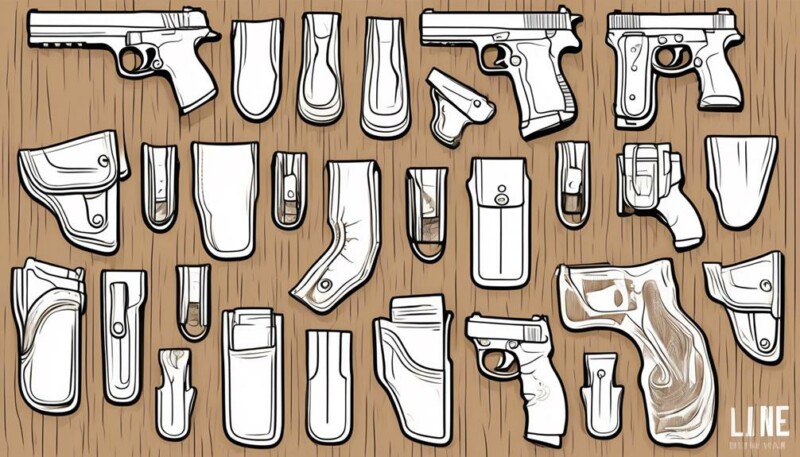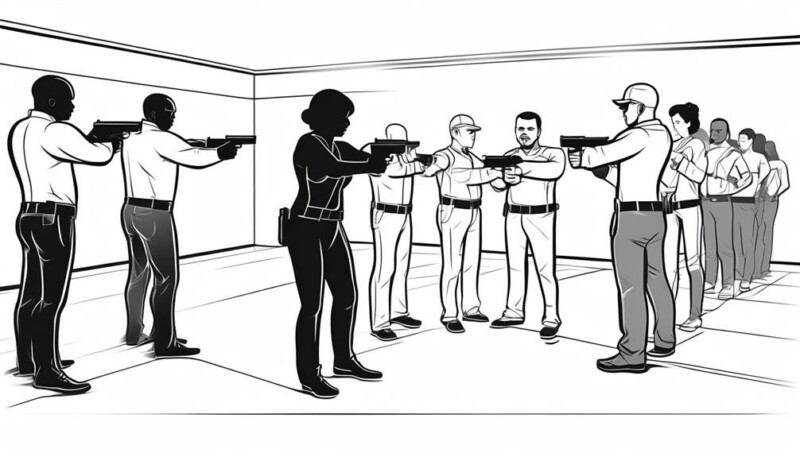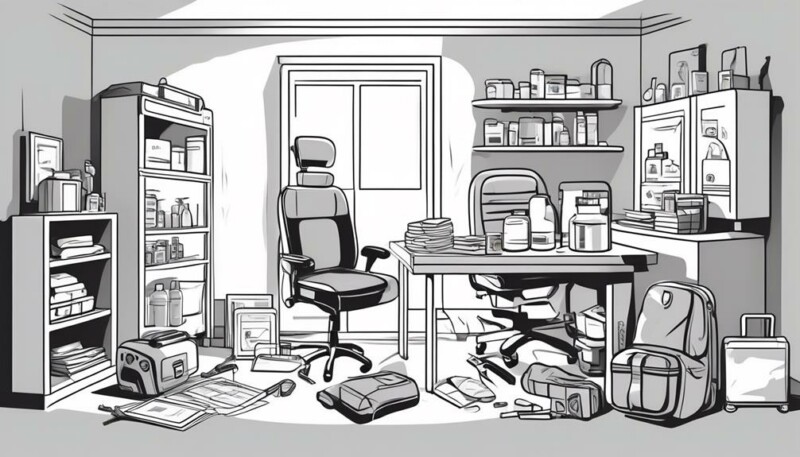So, you've decided to take your personal safety into your own hands and explore the world of concealed carry. Well, buckle up, because 'Mastering Concealed Carry: A Guide on Firearm Safety' is about to become your trusted companion on this journey.
In this guide, we'll dive deep into the realm of responsible gun ownership, equipping you with the knowledge and skills necessary to confidently carry a concealed firearm. From choosing the right firearm and holster, to understanding the laws and regulations surrounding concealed carry, this guide has got you covered.
But that's just the beginning. Get ready to unlock a world of practical tips, expert advice, and essential insights that will empower you to navigate the concealed carry landscape with confidence.
So, are you ready to step into a world where safety is paramount and knowledge is power? Welcome to 'Mastering Concealed Carry: A Guide on Firearm Safety.'
Key Takeaways
- Understanding and complying with state and local concealed carry laws is essential for responsible firearm ownership.
- Choosing the right holster that prioritizes comfort, retention, and security is crucial for safe and effective concealed carry.
- Practicing proper trigger finger discipline and following firearm safety rules can help prevent accidental discharges.
- Regularly maintaining and inspecting holsters, as well as practicing drawing techniques, are important for efficient and safe concealed carry.
Concealed Carry Laws and Regulations
Are you wondering how to navigate the complex world of concealed carry laws and regulations? It's crucial to understand and comply with state and local concealed carry laws to ensure your safety and the safety of those around you. To legally carry a concealed firearm, you need to obtain the necessary permits and licenses required by your jurisdiction.
It's essential to stay updated on any changes or updates to these laws to avoid any legal complications. Familiarize yourself with the restrictions on carrying in certain locations or establishments. Some places, such as schools, government buildings, and private property, may have specific regulations prohibiting concealed carry. Being aware of these restrictions will help you avoid any legal consequences.
To navigate the intricacies of concealed carry laws and regulations, seek professional advice or guidance. There are concealed carry training programs available that can provide you with the necessary knowledge and skills to responsibly carry a concealed firearm. These programs focus on situational awareness, responsible gun ownership, and gun safety.
Firearm Safety Rules for Concealed Carry
When it comes to concealed carry, there are two important firearm safety rules to keep in mind:
- Holster selection: Choosing the right holster is crucial to ensure your firearm is secure and concealed from view.
- Trigger finger discipline: Always remember to keep your finger off the trigger until you're ready to shoot, as this helps prevent accidental discharges.
Holster Selection
To ensure the utmost safety and convenience while carrying a concealed firearm, selecting the right holster is of paramount importance.
When it comes to holsters, there are a few key factors to consider. First, think about the type of carry you prefer. Inside-the-waistband (IWB) holsters are great for discreet carry, while outside-the-waistband (OWB) holsters offer accessibility.
Next, prioritize comfort. Look for holsters that won't cause discomfort during extended wear.
Retention and security features are also crucial. A good holster should securely hold your gun in place, preventing accidental dislodging.
Finally, don't be afraid to test different holsters to find the one that suits your lifestyle. Remember, proper training and adherence to firearm safety rules are essential when carrying concealed.
Trigger Finger Discipline
Ensure the utmost safety and confidence in your concealed carry by practicing proper trigger finger discipline at all times. By following these guidelines, you can minimize the risk of accidental discharges and promote a safe shooting environment.
- Always keep your trigger finger outside the trigger guard until ready to fire. This prevents any unintentional trigger pulls.
- Maintain a straight and indexed trigger finger when not actively engaging a target. This ensures that your finger remains clear of the trigger and reduces the chance of an accidental discharge.
- Ensure your trigger finger remains clear of the trigger when holstering or re-holstering your firearm. This prevents any mishaps during the process.
- Avoid any unnecessary contact with the trigger to prevent accidental discharges. Keep your finger disciplined and away from the trigger until you have a clear target.
- Consistently practice and engrain trigger finger discipline for safe concealed carry. Regular training and repetition will help you develop good habits and promote firearm safety.
Holster Selection and Proper Usage

When it comes to choosing a holster, you want to find one that allows for discreet carry while still being easily accessible. Inside-the-waistband (IWB) and outside-the-waistband (OWB) holsters each have their own advantages, so it's important to consider what works best for you.
Comfort, retention, and security features should also be taken into account. So, take the time to test out different holsters and seek professional guidance to ensure you make the right choice for your lifestyle.
Holster Types: Options and Features
For a discreet and accessible way to carry your firearm, consider exploring the various holster options and features available to you. When it comes to concealed carry, finding the right holster is crucial for both comfort and safety.
Here are some options and features to consider:
- Inside-the-waistband (IWB) holsters: These provide a discreet way to carry your firearm while keeping it close to your body. They're often worn inside the waistband, offering optimal concealment.
- Outside-the-waistband (OWB) holsters: These holsters are worn outside the waistband, making it easier to access your firearm quickly. They're a popular choice for open carry.
- Comfort: Look for holsters that prioritize comfort during extended wear. Features like padded backing and adjustable straps can make a significant difference.
- Retention and security: Evaluate the retention and security features of different holsters. Look for adjustable retention screws or passive retention systems to ensure your firearm stays securely in place.
- Try before you buy: It's essential to test various holsters to find the one that suits your lifestyle and needs. Consider factors such as draw speed, concealability, and overall comfort.
Drawing Techniques: Efficient and Safe
To draw your firearm efficiently and safely, it's crucial to select the right holster and use it properly. Consider inside-the-waistband (IWB) holsters for discreet carry and outside-the-waistband (OWB) holsters for accessibility. Look for holsters that provide comfort during extended wear and evaluate their retention and security features.
Test various holsters to find the one that suits your lifestyle and allows for re-holstering without using your support hand. Practice the 'fist full of garment' technique to draw with your cover garment out of the way. Body shields can also provide added protection.
Remember to continuously train and familiarize yourself with the laws and regulations on concealed carry. Seek professional advice or guidance when selecting your firearm.
Holster Maintenance: Cleaning and Inspection
Regular cleaning and inspection of your holster is essential for maintaining its functionality and ensuring safe and reliable firearm carry. By properly maintaining your concealed carry holster, you can prolong its lifespan and ensure that your firearm is always ready for use.
Here are some important steps to follow when it comes to holster maintenance:
- Clean your holster regularly to remove dirt, dust, and debris that can accumulate over time.
- Inspect your holster for any signs of wear or damage, such as loose stitching or broken retention straps.
Ensure that your holster is compatible with your specific firearm and that it fits securely.
- Practice dry fire exercises to familiarize yourself with your holster's draw and re-holstering process.
- Remember that safety should always be your top priority. Keep your finger off the trigger until you're ready to shoot, and always assume that the gun is loaded.
Concealed Carry Training and Certification

Start your concealed carry journey by understanding the importance of firearm safety and responsible gun ownership.
When it comes to concealed carry, staying safe should be your top priority. To ensure you have the necessary skills and knowledge, it's crucial to undergo proper training and obtain certification.
First, find a reputable concealed carry training course or instructor. Look for programs that cover not only the basics of firearms safety and handling, but also provide instruction on the different types of concealed carry holsters and how to properly use them.
A good training course will also familiarize you with state laws and regulations regarding concealed carry permits and licenses. During your training, expect to practice shooting drills and participate in training scenarios that simulate real-life situations. These exercises will help you develop the necessary skills to handle your firearm safely and effectively.
By experiencing different scenarios, you'll learn how to make quick and accurate decisions in high-pressure situations.
Situational Awareness and Threat Assessment
Developing situational awareness is crucial for assessing potential threats in your surroundings and ensuring your personal safety. To enhance your situational awareness, there are several key tips you need to know:
- Pay attention to your surroundings: Be aware of the people, objects, and activities around you. Avoid distractions like phones or headphones that can limit your awareness.
- Understand threat indicators: Learn to recognize suspicious behavior or signs of danger. This can include someone acting erratically, wearing inappropriate clothing for the weather, or exhibiting signs of aggression.
- Scan your environment: Regularly scan your surroundings to identify potential threats. Look for anything out of the ordinary or anything that may pose a risk to your safety.
- Identify escape routes: Always be aware of possible exit routes in case of an emergency. This can include identifying doors, windows, or alternative routes to quickly leave a dangerous situation.
- Seek professional training: Consider enrolling in self-defense courses that focus on threat assessment and situational awareness. These courses can provide valuable knowledge and skills to help you effectively respond to potential threats.
Emergency Preparedness and Response

To effectively respond to emergencies and ensure your safety, it's essential to have a well-prepared and practiced emergency response plan in place. When it comes to concealed carry and firearm safety, being prepared for unexpected situations is of utmost importance.
In this section of the guide, we'll explore the key elements of emergency preparedness and response.
First and foremost, familiarize yourself with the safety rules of carrying a concealed firearm. These rules serve as a foundation for responsible gun ownership and can greatly reduce the risk of accidents or unintended harm. Remember to always keep your finger off the trigger until you're ready to shoot, keep the firearm pointed in a safe direction, and be aware of your target and what lies beyond it.
Next, consider incorporating emergency response training into your routine. This can involve scenarios where you simulate potential threats and practice drawing and firing your weapon accurately and efficiently. Additionally, learn how to use your support arm effectively to create distance or fend off an attacker if necessary.
In emergencies, time is of the essence. Therefore, it's crucial to have a well-thought-out emergency response plan that includes communication strategies, evacuation routes, and designated meeting points. Regularly review and update this plan to ensure its effectiveness.
Lastly, remember that emergency preparedness isn't just about being physically equipped, but also mentally prepared. Stay alert, practice situational awareness, and trust your instincts. By mastering emergency preparedness and response, you can enhance your safety and the safety of those around you.
Frequently Asked Questions
What Are the 4 Golden Rules of Gun Safety?
When it comes to gun safety, there are four golden rules you need to remember.
Firstly, always have a proper grip on your firearm to maintain control.
Secondly, practice trigger discipline by only placing your finger on the trigger when you're ready to shoot.
Thirdly, choose a holster that securely holds your weapon and allows for a smooth draw.
Lastly, never underestimate the importance of situational awareness to keep yourself and others safe.
These rules are crucial for anyone carrying a concealed firearm.
What Is the Best Safety for Concealed Carry?
The best safety for concealed carry depends on various factors, such as:
- The type of holster you choose
- Proper grip techniques
- The importance of trigger discipline
To ensure your safety, consider:
- Enrolling in concealed carry training programs that teach you the necessary skills and knowledge
Additionally, factors like:
- The type of firearm
- Proper storage at home
- Understanding concealed carry laws in different states
are crucial.
Always prioritize safety and stay informed to protect yourself and others.
What Are the Four 4 Cardinal Rules of Gun Safety?
The four cardinal rules of gun safety are crucial to remember when handling firearms.
Always treat every gun as if it's loaded.
Never point the muzzle at anything you don't want to destroy.
Keep your finger off the trigger until you're ready to shoot.
Be aware of your target and what's behind it.
These rules are the foundation of firearm safety and should be ingrained in every responsible gun owner's mind.
What Are the 4 Primary Rules of Firearm Safety?
The 4 primary rules of firearm safety are crucial for your well-being and the well-being of those around you.
Never forget the importance of proper training to handle a firearm safely. Avoid common mistakes by always treating every gun as if it's loaded and keeping your finger off the trigger until you're ready to shoot.
Understand firearm mechanics and practice safe storage options. Teach firearm safety to children and develop situational awareness.
Let's address misconceptions about concealed carry together.
Conclusion
Congratulations! You have now mastered the art of concealed carry and have become a responsible and well-prepared gun owner.
With the knowledge gained from 'Mastering Concealed Carry: A Guide on Firearm Safety,' you have the tools to confidently navigate the world of concealed carry.
Remember, safety and continuous training are key, so always stay vigilant and prepared.
Now, go forth and protect yourself and others, like a modern-day superhero with a hidden weapon.
Stay safe out there!
